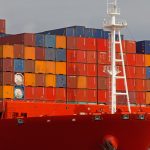Pallet Shipping Preparation and Services
Pallets form an indispensable foundation to the international freight forwarding industry. Worldwide shipments by sea and air would be severely restricted without palletized goods heading for intercontinental destinations. Thanks to this simple invention that’s been around for a century, pallets make long-distance product shipments safe and easy.
International pallet shipping relies on flat, portable platforms for securing, storing, handling and moving practically every conceivable class of goods. Pallets strongly support products and keep them stable while being handled and transported from shipper to receiver. Pallets also keep loads organized while remaining stationary in a warehouse.
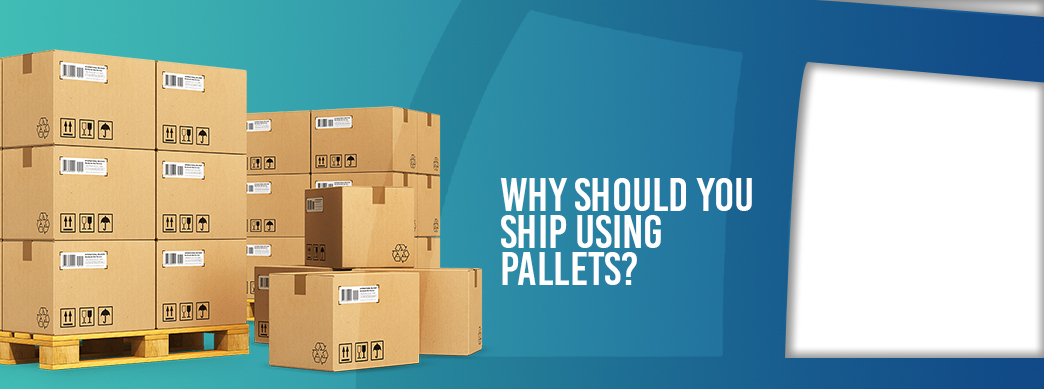 Why Should You Ship Using Pallets?
Why Should You Ship Using Pallets?
Pallet shipping is a proven freight movement process. Exporting pallet shipments is a huge business involving almost every country in the world. Importing pallet shipments into the United States is equally voluminous. Over 1.8 billion pallets circulate through America daily. Millions more serve the international freight market.
You should ship using pallets because it simply makes sense. Pallets are a staple of global freight movement where ocean container traffic grew by 4.8 percent over the last year and air freight metric-ton-per-km increased by 9 percent. Most of these freight shipments involved palletized loads.
Business pallet shipping depends on uniform infrastructure. The freight industry implements specific pallet designs that meet market requirements of their destination point. This might be sanitized pallets that prevent invasive plant or insect species from entering foreign ports. Uniform pallets also serve return and recycling systems where international freight loads exchange on a regular rotation.
By using pallets for your international shipping needs, you’re part of a global economy that relies on proven principles. Material handling equipment manufacturers design forklifts and trucks to work with accepted pallet sizes and materials. Palletizing your products for industry-standard procedures ensure your shipments fit into the flow rather than buck the tide.
Using pallets to move your commercial products gives you considerable benefits compared to other freight handling options. Pallets are universally accepted shipping aids that remove handling obstacles and replace them with transportation solutions. Here are some of the benefits you’ll gain when you ship using pallets:
- Pallets are economical to purchase and exchange.
- Valuable products are protected by shipping on pallets.
- It’s easy and fast to secure and move goods on pallets.
- Pallets maximize space in warehouses, container ships and cargo planes.
- Palletization allows many individual units to ship as one entity.
- Worldwide material handling equipment fits with universal pallet design.
- Pallet options include wood, plastic, aluminum, steel and cardboard.
- Shipping by pallets protects material handling workers.
How to Prepare Freight Shipments on Pallets
Preparing freight shipments on pallets starts with selecting the right pallet. Your pallet has to have sufficient strength to support your load’s weight and specific characteristics. Your pallet also has to meet international standards and sizes for its destination point. Here are the common international pallet categories:
- North American pallets use the Imperial measuring system based on inches.
- European pallets use the Metric System of Measurement and rely on millimeters.
- International Organization for Standardization (ISO) pallets also use millimeters.
- Australian standard pallets sizes are unique to that continent but fit regular lifts.
It’s important to select compatible pallets for their receiver and to use the right material for your pallet construction. The worldwide pallet industry offers you these options to prepare your freight shipments:
- Wooden pallets: Wood is by far the most common pallet construction material. Wood is economical, plentiful and renewable as well as recyclable. Wood pallet strength varies depending on whether it’s constructed from hardwood or softwood materials. Wood pallets might not be an option for sensitive goods unless they’re treated by heat or chemical processes.
- Plastic pallets: Plastic is an attractive pallet option for loads meeting International Plant Protection Convention (IPPC) approval. By nature, plastic is an inert material that easily sanitizes. It’s also strong and holds significant weight. Most plastic pallets use high-density polyethylene (HDPE) or polyethylene terephthalate (PET), which are safe and economical materials.
- Aluminum pallets: Aluminum is lightweight making it attractive for air cargo shipments. Pallets made from aluminum are also exceptionally strong compared to their weight. Although aluminum pallets last almost indefinitely, they’re expensive to purchase and are often release at their final destination making it difficult to recover or reuse them.
- Steel pallets: Steel is the heavy-duty pallet option for large-capacity loads such as fuel drums or industrial machinery. Steel is also heavy on its own and costs more. You’ll rarely see steel pallets used for air cargo, but they’re ideally suited for ocean-going containers.
- Cardboard and pressboard pallets: Paper and wood fiber pallets are cheap to buy and lightweight to ship. Because of limited strength and potential damage from shipping elements, cardboard and pressboard pallets seldom meet the needs of most intercontinental freight forwarders. Therefore, you’re better off preparing freight shipments on other pallet types.
The key to successful pallet preparation is properly organizing the load. Pallets in transit are subjected to motion forces like accelerating, cornering and braking. The same gravitational effects governing land-based truck shipments also apply to ocean and air transport.
Shock and vibration are also mobile threats to pallet loads. The rule-of-thumb for load preparation is ensuring the pallet is tightly packed, and the load’s center of gravity is as low to the bottom as possible. This avoids top-heavy loads that easily tip.
Preparing pallets for shipping also involves load profiles. In the palletized shipping industry there are three common profiles for product placement that determine how a load should be packaged and protected. The profiles are:
- A-profile: This is the most common and safest method to load a shipping pallet. A-profile loads conform to the pallet’s outer edges allowing for a secure bond between the pallet and the products.
- B-profile: This profile is common but not as secure as a uniform A-profile load. Here the products conform to the pallet’s base dimension but overhang it through vertical stacking.
- C-profile: This is the least desirable way to prepare a pallet for shipping. C-profile loads overhand the pallet’s outer boundaries right at the base making it difficult to ensure a bond between the pallet and its load.
Once pallets are loaded and packaged to best protect the products, they can be prepared for shipment.
Protecting Your Palletized Freight Shipment From Damage
Choosing the proper pallet is only part of preparing a palletized freight shipment. Having the right pallet base under your load is crucial, but truly protecting the shipment involves more than pallet selection. Safe product loads employ special securing techniques and devices to build an overall package that will survive ocean or air transit.
Experienced shippers routinely use product protection aids to safeguard palletized loads. Pallet protection devices are usually incorporated in packaging methods, and their specific function depends on the unique application the load requires. Here are the common ways of protecting your palletized freight shipment from damage:
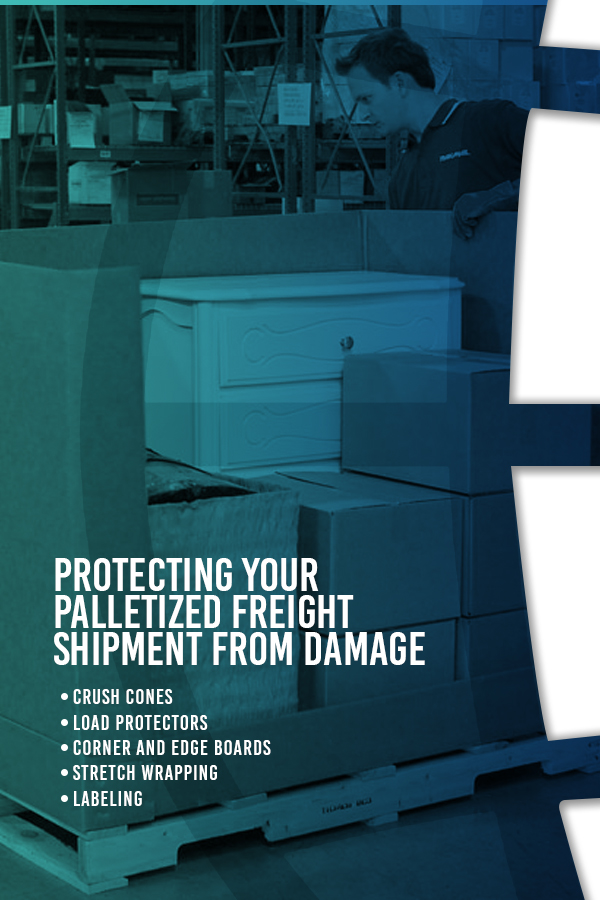 Crush cones: A major risk of pallet load damage is crushing. While some loaded pallets are designed for multiple layers of pallets to be stacked on top of each other, other loads are highly vulnerable to crush. To protect against crushing by accidentally stacking weight on top of a vulnerable load, the industry uses a simple device. It’s called a crush cone, which is a pyramid-shaped product that’s centrally placed on top of a load. This warns material handlers not to stack anything over the protected palletized load.
Crush cones: A major risk of pallet load damage is crushing. While some loaded pallets are designed for multiple layers of pallets to be stacked on top of each other, other loads are highly vulnerable to crush. To protect against crushing by accidentally stacking weight on top of a vulnerable load, the industry uses a simple device. It’s called a crush cone, which is a pyramid-shaped product that’s centrally placed on top of a load. This warns material handlers not to stack anything over the protected palletized load.- Load protectors: These are straightforward protective aids that help secure and pad products placed on a shipping pallet. The simplest load protectors are paper, cardboard or plastic sheets positioned between product layers to help distribute the weight across the entire pallet footprint. Foam pads are also used as load protectors. They can fit between layers or be strategically set in vulnerable horizontal or vertical spots. Corrugated cardboard products are excellent load protectors as they absorb some irregularities inside the load.
- Corner and edge boards: Palletized loads significantly benefit from corner and edge boards. These products protect the load’s exterior points from damage by impact by material handling equipment and other palletized loads being placed beside them. Corner and edge boards also protect products from damage by conventional securing methods like banding and stretch wrapping. Corner boards strengthen loads to prevent lateral shifting while edge boards stop bands and wrap from cutting into finished packaging. Common corner and edge board materials include solid fiber, honeycomb fiberboard, multi-wall corrugated cardboard and preformed SonoPosts®.
- Stretch wrapping: If there’s one sure-fire way of protecting your palletized freight shipment from damage, it’s using stretch wrap to secure your load to the pallet. Stretch wrap also contains your product load within itself. Stretch wrap film comes in various weights, strengths and colors and has specific applications based on load contents and configuration. The benefit of stretch wrap is its elasticity and material memory. Stretch wrap expands under tension when applied manually or mechanically. Once applied, the film’s properties allow it to return to its original form thereby gripping and squeezing the palletized load.
- Labeling: Identifying a palletized load of products is an equally important part of overall protection. The freight forwarding industry has unique labeling systems that allow tracking through progressive identifiers (PRO labels) and warnings. Loads clearly labeled as “Fragile,” “Handle With Care” or “Do Not Stack” stand out to material handlers and direct them away from accidental damage. The key to effective labeling loads is to position the markers so they’re readily visible and not easily blocked by adjacent palletized loads.
Properly protecting palletized loads ensure that products are shipped effectively and without loss due to damage during shipment.
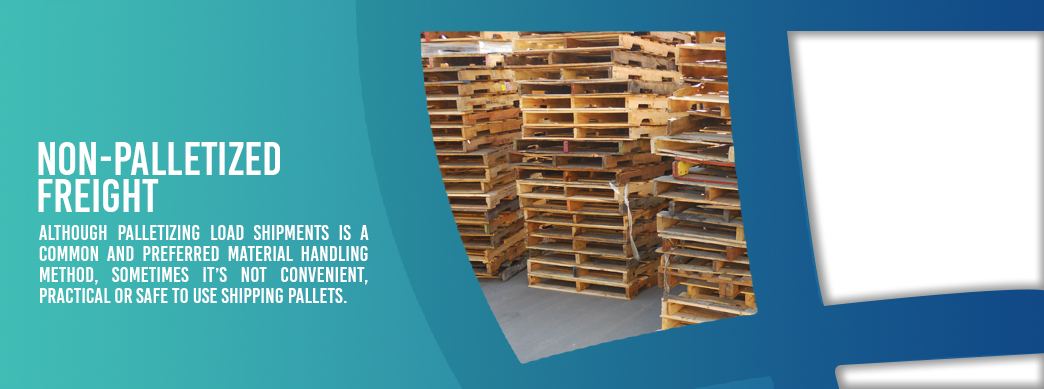 Non-Palletized Freight
Non-Palletized Freight
Although palletizing load shipments is a common and preferred material handling method, sometimes it’s not convenient, practical or safe to use shipping pallets. This might be when goods are vulnerable to damage or theft or overly sensitive to the weather of internal shipping conditions like light or humidity. In those cases, non-palletized freight methods are preferred.
The basic non-palletized container is a shipping crate. For years, international freight handlers used wooden crates and barrels. Wood is still a common commodity for building non-palletized shipping crates, but barrels are mostly obsolete except in some liquid shipping applications.
Non-palletized freight containers come in all shapes, sizes and material selections. Ocean cargo systems usually involve sea containers. Air shipments are weight sensitive, so they often use plastic or composite non-palletized containers.
Wood containers are still the first choice for many product movements. You may recognize completely enclosed wooden shipping crates from photos or movies where they’re used to preserve priceless artifacts. However, most shipping crates are skeletal designs. They’re carefully constructed of wooden ribs to surround and protect the contents.
The freight handling industry uses non-palletized container terms that you should be aware of. Universal shipping by sea and air divides freight into full container loads (FCL) and less than full container loads (LCL). Land-based trucking also utilizes the terms full truckload (FTL) and less than full truckload (LTL). These divisions equally apply to palletized and non-palletized freight.
Importing and Exporting Freight on Pallets as a Business
Internationally importing and exporting palletized and non-palletized shipments is a major worldwide business. Though growth is slowing, the global economy is still projected to expand by 3.5 percent in 2019 meaning international freight shipments are on the rise as well. As volume rises, so does the complexity of moving freight to and from foreign docks and airports. Unless you’re experienced in international cargo handling, you’re best off working with a professional freight forwarder. Here are the benefits you’ll get by choosing a professional logistics partner:
- A one-stop shop for all logistics and international shipping needs
- Personalized, reliable and transparent service by experienced staff
- Expertise to handle unique challenges that arise in international shipping
- Seamless processing of complicated customs and declaration documents
- Cargo insurance to protect you against all unforeseen incidents and loss forms
- Computerized tracking services, so you’re always aware of product movement
- Pick-up and delivery service at the point of departure and arrival
- On-time delivery and receipt of international cargo shipments around the world
- Versatile options in sea freight, regular air shipments and expedited air cargo
- Competitive freight rates and guaranteed prices meeting your expectations
- Continual contact with your freight forwarder throughout a shipment
- A long-term relationship with your cargo forwarder for a solid business return
An experienced and professional freight forwarder will assess your particular shipment requirements and implement them with an economical and efficient transportation system. Certain product movements may be most suitable for ocean travel. For faster service with time-sensitive products, air freight could be the best shipment method. In urgent cases and with small-volume shipments, an express air delivery might serve you best. Or, for long-term storage, you may need warehousing.
Your experienced freight partner will assess your palletized or non-palletized load requirements and blend it with the right combination of FCL or LCL shipments. The key to international shipping success is selecting a professional freight company with the experience and contacts to help you focus on what you do best — building your business.
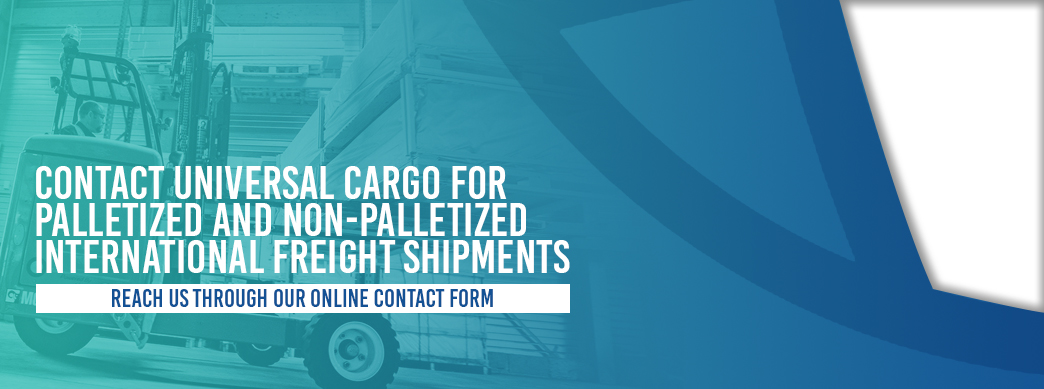 Contact Universal Cargo for Palletized and Non-Palletized International Freight Shipments
Contact Universal Cargo for Palletized and Non-Palletized International Freight Shipments
Universal Cargo is a professional freight forwarder that meets all your business shipping criteria. We’ve forwarded international freight since 1985 and have built solid international contacts. With that, Universal Cargo can help your United States business import and export palletized and non-palletized freight worldwide.
If you’re considering international shipment of products in or out of America, contact Universal Cargo today. Call us at 424-888-7959, or reach us through our online contact form.


